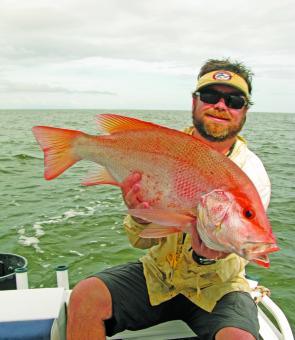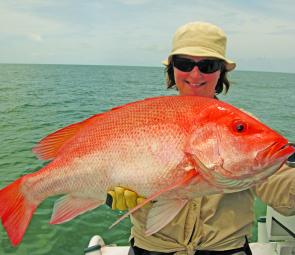All this cold weather has meant that the usual snapper run has continued past July and looks to be here for a short time yet.
We don’t get the numbers of snapper that the southern crews get and mostly not enough to target them alone. But they do venture into shallow waters in ones and twos with other red fish like nannies and even sweetlip.
The known spots where you can pick up the very welcome by-catch are Conical Bombie, Ross’s Reef, Outer Rock, Man and Wife and the closer rubble patches. They feed in as little as 6m at night, though generally the 14m mark seems to be the best chance.
Snapper up this way will hang along the rubble patches away from the main structures apart from the new moon where they congregate around the pinnacle structures for spawning. On a dive trip a few years ago at a local black jew ground we saw a huge school circling a tall spike and other than getting right in among them nothing fazed them from their determined mission.
This find has helped us to calculate the best time to go looking and the new moons in June, July and August has seen our better catches. The deeper fern country holds snapper all year mixed with the big red emperor and large-mouth nannies.
We have taken our bait techniques from the southern guys who are much more in tune with snapper. Floating down a pillie with a very small pea sinker has yielded the best results for us in the shallow waters of Keppel Bay.
Copying this method has also led to more consistent catches of red throat emperor on the shoals and other patches that receive plenty of attention from anglers. We have been getting quite a few snapper near the wrecks up north while we are chasing red fish.
Red emperor and large-mouth nannygai have come in once more to the rubble areas within range of the average offshore rig. We have found at this time of year our best captures are after lunch when the northeaster is starting to blow along the coast, we slip outside where it virtually has no effect.
I continually see other boats roar up to their mark, drop the pick and start fishing usually with very little success, while other boats not far away are cleaning up. It pays to find the fish or at least the bait schools before setting up for a big session. We used to drift over the patch randomly picking up a red here or there but now days as our good catches have become regular our methods have changed. Don’t rush yourself, be prepared to spend a bit of time locating your targets on the sounder before anchoring.
Sometimes it is as easy as drifting until you score the first big red and then stay there. The trouble with drifting is that you can spread a school over a whole reef as some fish follow the baits each drift. If you anchor once you find the fish you can keep them grouping around the immediate vicinity with a bit of berley and increase your catch.
Most guys think ‘messy pot’ when you talk berley but it doesn’t have to be that way at all. When fishing for the big red fish they prefer a large bait on or very close to the bottom so why not put a sacrificial bait (berley) on the top hook of your patanosta rig. Try half mashing a couple of pillies and loosely putting them on the top hook so they break apart with the current or pickers and attract the bigger fish to your waiting bigger bait. Sometimes you might get a decent fish on the berley hook.
Monster bream remain active around river mouths and headlands. The larger size bream hang around these areas picking off the hardiheads, small fish and oysters in between the rocks and snags. Cold nights and cold water temps seem to bring the best out in the bream.
My dad, who passed away this year, was a bream specialist who spent many nights with a thermos at Jumpinpin or the Blue Hole at Caloundra. He always said that you had to be just a bit uncomfortable to get the best catches and watching him get seven bream for 21lb cleaned on a night that we had to put our hands in the water outside the boat to keep them warm gave me good grounding.
I try all his tricks up here and most of them work well, except for fowl guts for some reason. Use a trace of 1m from a size two hook to a small swivel and the smallest possible sinker to let your rig stay down deep.
On the sandy bottom adjoining fallen timber cast just wide and let the current take your gear into the edge of the sticks and hang on. Yabbies, prawns, mullet flesh and guts, hardiheads and herrings are the baits of choice.
Queenfish (queenies, skinnies) have come back on at Corio Bay and around The Keppels. Corio Heads is a prime spot where baits or poppers work equally well. The incoming tide before high is the best; head out past the bombies on a line that takes your drift along between the bombies and the headland.
Put a live herring on the bottom with a small pea sinker holding it down then drift past the rocks throwing your popper into the white water and retrieving as fast as you can. The queenies follow your lure and as one grabs the popper the others attack the livies and pandemonium ensues. I have tried lots of different outfits to catch these guys but the old Shimano TSS4 has no equal for speed with a 100mm popper.
The islands have two excellent spots one on each side of Great Keppel. The first is the hole created where the big boats drop the tourists onto the beach at Great Keppel. When the boats push up onto the beach and back out again they stir up the sand, attracting schools of hardiheads and herrings. When the boats stop the bait schools hang thickly down each side trying to seek cover and a feed at the same time.
I use a plastic that looks like a hardihead and fished over the white sand and gin clear water most fish find it irresistible.
The other top spot is Wreck Beach where you can see the big queenfish tearing along in the face of the little crystal clear waves. A cast net to get hardies or herring is the only other thing you need other than your rod and tackle and it makes a decent walk over to the sheltered side if there is a westerly blowing making it uncomfortable elsewhere.
Doggie mackerel are becoming more prominent as the prime spotty month of September gets closer. They have been making forays into the bat each time the water cleans up and in the early morning westerlies they seem to be one species unaffected when you fish under the curtain hard against the mainland or the back of the islands. Pillies and flashas are the two prized local methods and both account for a decent share of available fish caught.
Coral trout although active all year, appear to be much shallower in the cooler months. I can’t place enough importance on trying to catch them in very shallow water right up against the shale rock plates or cliff faces. Big live baits or flesh baits do the trick and extra big plastics work very well except I lose too many to the broken bottom to have a great catch rate.
Salmon, whiting, grunter and flathead are on the chew at present and the temperatures make a day out in the sun a very enjoyable experience, so go out and enjoy.
Reads: 4174
Nannygai have come on the chew with vengeance this winter.

Occasional snapper might be mixed in with staple reef reds like this nannygai.




